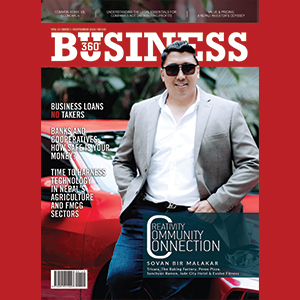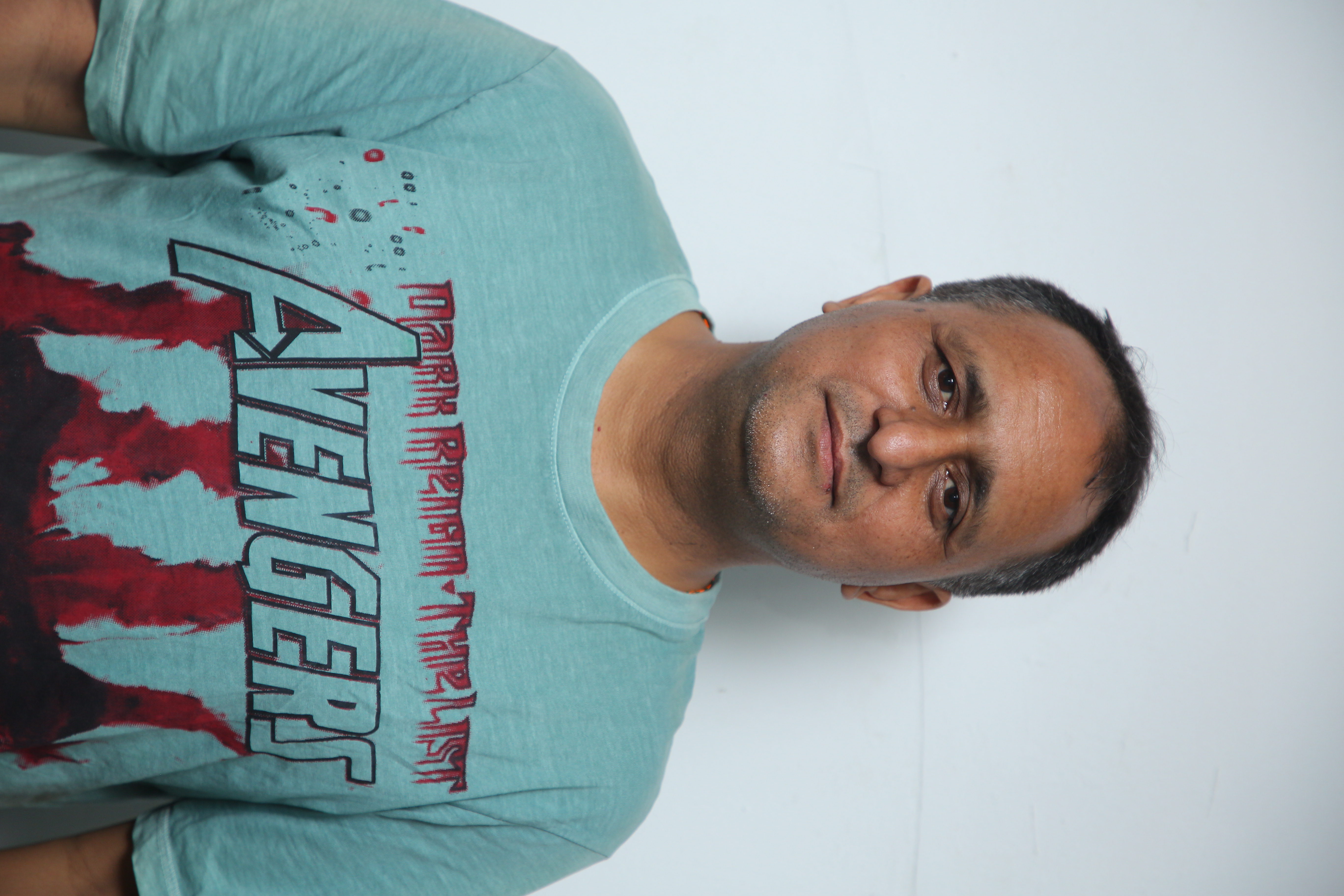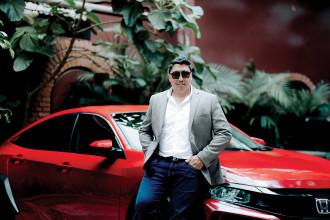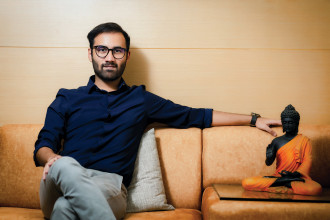-1724649458.jpg)
Raj Gyawali is a recognised name in Nepal’s tourism industry, known for his focus on innovation, prioritisation of community involvement, and environmental responsibility. As the Founder of Social Tours, a company lauded internationally for its commitment to responsible travel, Gyawali has been instrumental in promoting a model that benefits local communities and safeguards cultural heritage. With a background in tourism management and a deep-seated passion for sustainable development, he is a vocal advocate for practices that minimise tourism’s ecological footprint while maximising its positive impact on local economies.
Gyawali’s influence extends beyond Social Tours. He is an advisor at Karma Coffee where he helps integrate sustainability principles into their operations. Additionally, he offers his expertise as a consultant in sustainable tourism, guiding various organisations and projects seeking to strike a balance between tourism growth and environmental conservation. His commitment extends beyond tourism itself as he actively participates in initiatives promoting sustainable living and environmental stewardship in Nepal.
Gyawali is the also the Founder of Kora Cycling Challenge which initially started as a hobby but has over the years become a calendar event. This year, the Kathmandu Kora had a record 5722 participants, a number that only promises to grow. In this issue of Business 360, we spoke to Gyawali about what drives him to do what he does and what his work embodies.
What inspired you to start Social Tours?
It’s an interesting story. I was originally in manufacturing, specifically in handicrafts. Around 1998, my partner at the time, who was British, brought a group of students from the UK, and we organised a cataract eye camp in the mountains. That experience made me realise the profound impact tourism can have. The idea that social work and tourism could be combined had always been on my mind, and that’s how Social Tours came about. Although some people associate it with social media or social tourism, it’s really about using tourism to do social good.
-1724649478.jpg)
What was the transition from manufacturing to tourism like?
Interestingly, the transition wasn’t very challenging. You have to remember that in manufacturing, you are selling a product internationally – I was selling to H&M, for instance. In tourism, you are still selling a product, just one that doesn’t go away. So, my experience in export was very useful when I transitioned into tourism. Plus, I have always been interested in adventure, so it was a very easy transition for me.
Social Tours is synonymous with responsible tourism. What does responsible tourism mean, and how does Social Tours embody that philosophy?
That’s a very interesting question because responsible tourism has evolved significantly over time. Initially, we had eco-tourism, followed by sustainable tourism, responsible tourism, and now we are entering an era of transformational and regenerative tourism. These might seem like buzzwords, but each has a distinct meaning. Eco-tourism involves a list of practices that are environmentally friendly. Sustainable tourism expands on this, incorporating environmental considerations along with cultural preservation and long-term sustenance of destinations. Responsible tourism takes it further by placing the responsibility on both the company and the traveller to do the right thing. Transformational tourism impacts both the destination and the traveller profoundly, while regenerative tourism seeks to restore and revive traditional practices. It’s a deeper transition at each stage.
When I started Social Tours, we were focused on responsible tourism, but now we are moving towards transformational and regenerative approaches. Responsibility is embedded in what we do, and we are constantly striving to take it to the next level.
It’s an internalisation process. The whole idea is about embedding these principles into our policies and practices. For example, from the very beginning, we decided not to vertically integrate. In business, vertical integration means owning everything in the supply chain, but we chose to distribute the economic benefits throughout the community, as we see that as our responsibility. As a result, Social Tours still doesn’t own any cars; we rent vehicles from the market to avoid adding to environmental burdens, even if our operations might inadvertently contribute to them. We have made significant decisions like no longer printing materials; when we did, we ensured they were recycled. It’s about internalising these practices, not just putting them on paper, but going deeper and deeper into them. We also train our guides, engage with the industry to drive improvement, and lead by example. It’s a continuous journey of trying to walk the talk, because even now, people can point out issues, and there will always be challenges. But as long as we are on a mindful path towards doing the right thing, that’s the journey we are committed to following.
When I started Social Tours, we were focused on responsible tourism, but now we are moving towards transformational and regenerative approaches. Responsibility is embedded in what we do, and we are constantly striving to take it to the next level. It’s an internalisation process. The whole idea is about embedding these principles into our policies and practices.
How do you select and design the experiences that you offer to travellers?
In tourism, every place has incredible depth. However, tourism often spreads like wildfire – people tend to focus on what’s already popular because it’s the easiest route. If Everest is successful, everyone promotes Everest. If Annapurna or Kathmandu Durbar Square works, they stick to that. But if you dig deeper, you can develop truly immersive journeys that are unique. For example, we offer a food trail in Kathmandu that explores the ancient markets of Asan, then moves to Kirtipur for Newari cuisine. We peel back the layers of a place, and fortunately, the market is moving in that direction. Travellers are seeking more unique experiences, and in Nepal, we are sitting on a gold mine. With 150 ethnicities, diverse landscapes from the Terai to the mountains, and an abundance of food varieties, there’s so much potential. It’s all about making the effort to delve deeper and reveal these layers. Almost everything here can be a tourism product – Nepal is a growing country, and even its people are tourism products, as travellers are fascinated by the stories of those who have achieved remarkable things, beyond just climbing mountains. For me, all these elements are like ingredients, and the canvas we have to work with is amazing. Fortunately, those who come to Nepal are adventurers at heart, whether that’s eating spicy food, exploring tough terrains, or trying rafting. Everything is an adventure here, and people appreciate the journey, whether it’s visiting a bhatti for momos or learning about shamanism. It’s not just in Kathmandu; these experiences are everywhere.
-1724649501.jpg)
Could you tell us about a memorable experience or feedback from a traveller that highlights the depth of a social tour?
Oh, we hear that all the time. Often, travellers tell us that it was the trip of a lifetime, that they’ve never experienced anything like it before. Sometimes it’s as simple as taking a cooking course – something basic, like learning how to make momos or dal bhat. They might say, “I knew how to make dal, but now I know exactly how to make it,” and that has transformed their lives. It’s a simple thing, but for some, reaching the top of a hill or achieving a personal milestone on a high peak is a life-changing achievement. When we see people deeply connect with a journey and realise how tourism can truly be, and when we hear back that we’ve transformed their way of thinking about travel, that’s when we feel fulfilled.
Recently, we have been working on a project focused on transparency. We are completely open with our travellers about how much money we make and who earns what; we call it financial transparency. Most of our travellers are shocked because no one else tells them where the money goes. But we do, and it’s a transformational experience for them. It’s like an open kitchen in a restaurant; you trust an open kitchen because it’s transparent. People used to think that an open kitchen would be dirty, but in reality, it forces everything to be clean. We are applying the same concept to tourism, opening everything up, and it’s a game changer – not just here, but globally.
You are today known for Kora Cycling. What inspired you to start Kora, and how has it evolved over the years?
Kora is a fascinating project that actually began with volunteering. Years ago, we collaborated with a UK-based company called Saga which brought over 50 volunteers aged 50+. The CEO wanted to send his 16-year-old son here, so he asked me to look after him. He mentioned the son had saved some money, so I suggested he earn his way around Nepal instead of relying on funds. We created a 50 km cycling route around Kathmandu, and the idea was that he’d fund his stay with the money raised from completing the ride. With his initial investment of around Rs 4.5 lakh, we started something akin to a charity. The first year was about route planning and testing it with him and a Nepali friend. We wanted to involve locals, so we encouraged a Nepali person to join the British participant, Max. That year, 35 people took part.
After sharing the experience on social media, we were overwhelmed by interest the following year. Anticipating 125 participants, we were astonished when 350 showed up. The next year, it was 1,000, then 1,700, and this year, an incredible 5,722 people joined from Nepal and even places like Singapore and Colorado. Clearly, there was a gap in the market for such an event.
Though Kora isn’t about profit, it has become a yearly highlight. We are now in talks with Lalitpur Metropolitan City to officially establish it as a city event. Cycling is healthy, sustainable, and a great alternative to motorbikes, so it aligns perfectly with the city’s goals. Kora has expanded rapidly, with 15 locations last year and 20 this year. It’s incredibly rewarding to see a hobby evolve into such a significant event.
What does Kora mean?
Kora is a Tibetan term for circumambulation, often performed around religious sites like Bouddha or Swayombhu. It’s traditionally done in odd numbers. We chose the name because our route circled Kathmandu clockwise, encompassing numerous temples. While it’s about more than just temples, the concept of circling a powerful centre aligns with the city’s historical and spiritual significance. The idea of a circuit is also practical, as it simplifies logistics compared to linear routes.
Nepal’s tourism is undeniably bright. Global trends favour experiential tourism, an area where Nepal excels. Our slogan, ‘A Lifetime Experience’, accurately captures the essence of what Nepal offers. However, to realise this potential, we must address the underlying issues and invest in developing the necessary expertise.
Are local communities involved in the Kora Cycling Challenge?
We are gradually increasing local involvement. We work with the Lalitpur Metropolitan City and wards to get them engaged. Currently, communities like Kirtipur participate by throwing water and playing dhime baja (traditional drums) for participants, which is the kind of engagement we are aiming for.
The vision is for Kora to become a modern-day cycling festival, similar to a traditional jatra (festival). It has a fixed date (third weekend of July) and a consistent route with minor modifications for road construction or unforeseen issues. We also keep adding new routes, like this year’s 140 km Kathmandu Valley circuit.
This consistency creates a layered effect. Kids can even guide lost participants because everyone knows the Kora route. Changing the route wouldn’t achieve this, and it’s why we maintain a consistent path – a crucial step towards establishing jatra status.
-1724649552.jpg)
You mentioned Kora being organised internationally too. How does that work?
Kora operates on a concept closer to copyleft than copyright. We design the event format, and anyone can follow it. It’s a simple model – Bhaktapur, Jhapa, or even Singapore can adopt the format by following the same principles. Local organisers simply implement the existing template.
What are your thoughts on the current state of tourism in Nepal?
Nepal’s tourism sector is a complex mix of immense potential and significant hurdles. While the country undoubtedly possesses the raw materials for a thriving tourism industry – breathtaking landscapes, rich culture, and adventure opportunities – we are currently in a state of limbo due to fundamental shortcomings.
Strategically, policy-wise and operationally, we have made critical errors. Our outdated tourism law, from the 1972 Coronation era, is woefully inadequate for today’s tourism landscape. The tourism ministry itself is primarily administrative rather than technical, ill-equipped to handle the complexities of modern tourism. Moreover, our human capital is misaligned. We have a surplus of trekking guides, cooks and housekeeping staff, but a critical shortage of professionals in marketing, finance and tourism technology. This incomplete ecosystem hinders our ability to compete effectively.
Despite these challenges, the future of Nepal’s tourism is undeniably bright. Global trends favour experiential tourism, an area where Nepal excels. Our slogan, ‘A Lifetime Experience’, accurately captures the essence of what Nepal offers. However, to realise this potential, we must address the underlying issues and invest in developing the necessary expertise.
It’s frustrating to witness a country with such immense tourism potential held back by systemic problems. But I remain optimistic that with the right strategies and leadership, Nepal can overcome these challenges and become a world-class tourism destination.
How do you see sustainable tourism or for that matter, responsible tourism evolving over the years in our country?
Sustainable tourism is already taking root in Nepal, driven by local communities taking ownership. The Pasang Lhamu Municipality managing the Everest region themselves is a prime example. They are setting guidelines, collecting funds, and developing the area on their terms. This local ownership is crucial for sustainable tourism. It ensures equitable wealth distribution, minimises environmental impact, and preserves cultural heritage. Policy support needs to accompany this ownership to provide guidance.
Nepal’s rural tourism focus is another positive step. However, ensuring money stays within these communities remains a challenge. Recording, utilising local resources and empowering local government are key. Nepal is no longer solely Kathmandu-centric, and empowering provincial tourism further enhances sustainability. The main hurdles are capacity, will and demand. Achieving critical mass is essential – just like our Mayor Balen Shah’s walking street project wouldn’t work without sufficient participation.
Transformational tourism is a concept that looks at tourism as a powerful vehicle of change, both to transform travellers and destinations. Done well, it educates travellers on how to travel and with minimal negative impact, changing their choices and thought processes for the better.
What are some trends in tourism that Nepal maybe overlooking? What advice would you give policymakers to ensure tourism grows in Nepal?
I think Nepal does try to align itself to every trend that it sees, and that is essentially the problem of destination development in Nepal. One global trend is towards more and more experiential tourism - more experiences based, and Nepal is a goldmine for it. I just came back from a Shaman Festival in Temal. It’s phenomenal, and this happens all over the country. Our country is a goldmine for experiential tourism but we do not focus, instead trying to grasp at every niche that is possible and every trend that comes by. If we focused on the brand identity that we identified for ourselves in 2019 – Lifetime Experiences – that’s all that Nepal would have to do. Almost everything in Nepal is about lifetime experiences – I like to joke that the toilets at the airport when you arrive is a lifetime experience – it starts that soon. That is one brand promise we can deliver in Nepal – over and over again – every time people meet Nepalis, encounter our hospitality, climb a mountain, turn a corner and get another view, understand how Nepal lives with 150 different ethnicities in peace – it is a lifetime experience.
What Nepal’s tourism needs to do, is just focus, and not get distracted by every niche that looks something to run behind. What policy makers need to do is to align the whole tourism eco-system to this brand promise, and it will be loud and effective.
What are some new opportunities in tourism for young startups or new entrepreneurs?
Currently, the biggest opportunity that Nepal has in tourism is about spread. Tourism has traditionally been concentrated in just a few areas, and our arsenal of tourism experiences is very small, while the potential is great. With federalism came more local control and more funds in local areas. The opportunity that this provides is creating these localised experiences, and marketing it online effectively. This will essentially lead to a good diversification of experiences to be had in Nepal, and these experiences can also be financially viable. The market exists – it just needs to be done. Another opportunity is for tertiary services in tourism – finance, marketing, IT, etc. We are very weak at this. Startups that provide professional services would be much in demand.
How do you rate Nepal on current tourism sustainability practices?
Nepal is a unique destination in terms of sustainable practices – if we say it’s not there, it’s not true, and if we say we are doing it well, that’s not true either. Most of Nepal’s tourism happens in rural areas, hence there is a good spread of money into the local economy – one of the crucial indicators of sustainable tourism. Our protection of nature vis-a-vis tourism, at least in national parks is also quite good. But while we have this, our mindless development of tourism, is a total disaster in sustainability. We mindlessly build roads that are unsustainable, towers on every hill, flood villages in the name of homestay tourism, and the amount of cultural commodification is huge. So really, it’s a case of not focusing on our inherent strengths and going even deeper and layering it in, but mindlessly developing and allowing any form of development to take place.
What are some positive indicators in realising transformational tourism?
Transformational tourism is a concept that looks at tourism as a powerful vehicle of change, both to transform travellers and destinations. Done well, it educates travellers on how to travel and with minimal negative impact, changing their choices and thought processes for the better. On the other hand, it positively impacts destinations and communities, not only economically, which is the easy bit, but through connections, regenerative practices, and also through change in thinking. This is probably the most powerful concept in tourism today.
It’s not always easy to align one’s ideals with one’s needs – monetarily especially. Which values guide your work (and life)?
I am very aligned, or at least try hard to align myself to the concept of the control of greed. I even did a TEDx talk on that. Greed is a human tendency and we all have it. Somehow to drive us to achieve more, strive harder, etc. However, if we find ways to control greed, we end up living in a realm of sufficiency, to me, an ideal life to live by. Do just enough, and not more. However, to reach this, there are lifestyle choices one has to make. For example, we do not have a house that we own, nor do we own a car, and as a spin-off – we do not have debt either. But it’s a conscious choice, and comes with its own set of issues. One has to be able to make certain of the lifestyle choices to live by one’s ideals. This ideal, controlling greed and working towards sufficiency, guides my work and life too.
What inspires you to do what you do each day?
What inspires me? I need to have fun in what I do. This does not have to be in massive doses, but even in tiny doses of fun. This keeps every day fresh and enjoyable.
As a tourism entrepreneur, what is the impact you wish to make?
As a tourism entrepreneur, I hope the way I run my business becomes inspirational, and exemplary and it has a positive impact all around – to the traveller and to the destination. I also hope that the business is dynamic, moving with the times, and constantly evolving. That’s what I can hope for.
What other organisations are you involved in?
Beyond Social Tours, I wear many hats. I consult for provincial governments, like Sudurpaschchim, helping them develop tourism products. In the Everest region, I also offer consulting services. Additionally, I collaborate with a Norwegian company to create unique tourism experiences around the world. This global approach allows me to share my expertise and passion for responsible tourism on a wider scale.
Currently, two projects hold my main focus. Stomp Software promotes transparency and ethical practices in tourism. On the other hand, resonate.travel is a global platform that empowers local communities by showcasing their stories as the driving force for tourism, moving away from reliance on international guidebooks. This platform integrates sustainability as a core principle.
Finally, my wife’s project, Karma Coffee, operates under the principles of a circular economy. Their coffee shop embodies sustainability by using local materials and even incorporates National Geographic learning materials to highlight their practices. All these endeavours, including Social Tours, work together seamlessly towards a more responsible and impactful tourism industry in Nepal.







-1727417937.jpg)